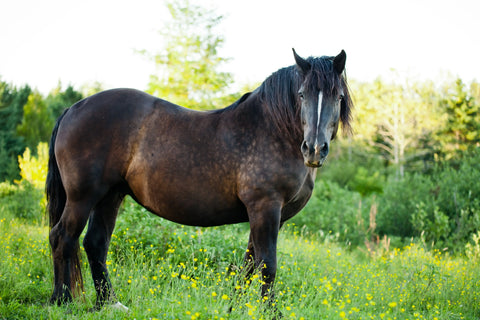
Horse Coat Colours Explained
of reading - words
In hippology, when we say horse dress, we refer to the color of the horse. Let's be clear, it's not about coat or fur. What color of horse’s coat do you like the most? To better answer this question, let's take stock of the list of horse coat colorsthat exist.
In principle, there are 12 horse dresses. Since we have classified them into two categories: simple dresses and composed dresses. However, it should be noted that many details make up the coat of an equine, which means that each horse has a unique coat.
The different colors of the horse's coat
How to define the color of the horse's coat?
Each horse dress is assigned a specific name. It is distinguished mainly by the combination of colors that compose it: the color of the hair, the color of the mane, the color of the skin and the eyes. Once the basic color has been defined, we can add the other particularities of the horse's coat, namely mixtures, variegations and additions.
The mixture of black hairs and white hairs constitute the mixtures. The white areas on the white dress form the variegations. Finally, the complementary characteristics of the equine make up the additions. These are added last, they concern the hair, skin and hair of the horse. Furthermore, there are the different brands and particularities that distinguish each stallion. However, these particularities are not for all horses.
The basic colors of the horse's coat
The simple coats of a horse are classified into 4 families, these are the basic colors of the horse's coat. The color that makes up each of these simple dresses is a single color, that is to say that its manes are the same color as its hair.
The Alezane dress: is made up of brown or fawn-colored hair and mane (possibilities of variations with the fawn color), fairly light skin, not pink, and dark eyes. From the family Chestnut, we distinguish the burnt chestnut dress, the café au lait dress and the palomino dress.
- The colored horse Burnt Chestnut has hair the color of roasted coffee, the same goes for its mane, its skin is black and its eyes are dark.
- The horse colored Café au laithas hair and mane in café au lait colors, its skin is light (not pink) and it has dark eyes.
- Horses with Palmino colors have light fawn hair which is more or less golden, white-silver mane which is lighter than the hair, their skins are black or gray (but never pink), then they have dark eyes (no blue).
The Black coat: consists of black hair, black mane, black skin and dark eyes. The equine may have white markings on the black coat and may not have any as well. In this black color family, we distinguish the black coat horses and the black pangaré or punctuated with fawn-colored hairs.
The Bai coat: consists of tawny hair, black mane, black ends, black skin and dark eyes. This category of horses has 3 coats: the Isabelle, the Sourisand the Bay. In this last family, we find shades of bay, namely dark bay, light bay and cherry bay.
- An Isabelle color stallion has yellowish hair, black manes, black skin and dark eyes.
- A stallion is Mouse color when he has ash gray hair, ash gray to black mane with black skin and dark eyes.
- A Bai colored stallion has tawny hair, black skin, black mane and dark eyes too.
Other horse dresses
In this family are classified the other colors of a horse's coat apart from Bay, Black and Chestnut. These are: Grey, Chocolate, White and Cream coat color horses.
- The gray coat: dark eye color, black skin, white hair and mane with the possibility of mixing with colors. The color of the gray horse's coat changes with age. The gray color represents different shades: light gray or dark gray, dove gray, speckled gray and trout gray.
- The chocolate coat: always dark eyes, dark skin and chocolate-colored coat.
- The white coat: white hair and mane, pink skin and white hooves, dark colored eye contours. White horses are rare, do not confuse them with gray horses.
- The cream dress. The stallion has light eyes, cream coat, white, even grayish mane, and pink skin. There are 2 types of cream horse: the cremello with white mane, lighter than the color of the hair and the perlino with grayish mane, darker than the color of the hair.
The colors of the horse's dresses
The colors of composite dresses are created through mixtures, variegations, additions as well as marks. These have different colors, or even the hairs which are also of another color.

The characteristics of the horse's coat
Horse genes
Genetic factors influence the color of an equine's coat. There are 8 genes:
- Gray gene named “G” ex: gray coat, grizzled bay, spotted gray cape.
- White gene named “W” white, very rare. Ex: foals at birth.
- Cream gene named “C”
- Dun gene named “D” or “wild” gene, like Fjord
- Champagne gene named “CH”
- Silver gene named “Z”
- Perle gene named “PRL” or “Barlink Factor”, not very common.
Mixtures
To constitute the color of the horse's coat, we have for example mixtures of hair. To do this, we must look closely at the percentage of white hairs and see whether the mixtures evolve over time or not.
3 cases are possible. If the mixture of white hairs is stable, we speak of a granite coat. If the blend is likely to change over time, it is a mixed dress. Also, if the mixture of white hairs evolves positively, the horse's coat is said to be graying. On the other hand, if the basic coat is made of amixture of black hairs, we can say that the coat is smoked. For example, the wolf pup is called a “smoked isabelle” dress.
Variegations
The variegations are the white areas or colored areas present on the basic coat of the stallion. There are different variations of variegation depending on their size, location and shape. There are two types of variegation: the pie type and the spotted type.
For the piebald horse dress, there are 5 variegations:
- Balzan Magpie: white limbs, belly and head, clear and regular contours.
- Pie tobiano: colored head, white limbs, vertical white areas, the topline has at least one white area, clear and regular outline of the white areas.
- Pie sabino: white head, very blurred and irregular outlines of the white areas, spotted variegation.
- Pie overo: white head, colored limbs, horizontal white areas, the topline has no white areas, outline of the white areas irregular and blurred.
- Pie tovero: white equine with some colored areas.
There are 6 of the spotted variegations:
- striped: with white stripes.
- leopard: white color, pink skin.
- cape or spotted cape, we also have the spotted pony: white variegation and pink skin underneath. In a piece on the rump, sometimes reaching up to the withers.
- bringé: with black stripes.
- marmorated: numerous white hairs, almost white coat.
Additions
Here are the possible additions:
- pink skin, black skin, champagne skin (pink skin with small black spots)
- silver horsehair, washed horsehair(lighter than the basic coat) or mixed horsehair(white and colored)
- Hairs lighter than the basic coat: coat with a pangaré effect (like the black pangaré), dappled(lighter round shapes),charcoal(small spots of black hair) or flake(small spots of white hair).
- Darker hairs on the coat: Moorish cape, scapular band(along the shoulders), mullet stripe (along the spine), crucial band(cross shape), zebra stripes(on the limbs).
White marks
The white marks are natural spots, made up of white hairs on pink skin. They are also used to identify the equine. To describe the white marks, we rely on anatomical landmarks: such as the eye line, the median axis or the median axis of the head. The name given to these brands will depend on their location.
- White mark on the front, we find the header
- White mark on the muzzle, it's thelist(if the list includes the tip of the nose, we have a uglyat the tip of the nose or agrayedat the tip of the nose). The middle axisof the chamfer corresponds to the axis of the list.
- White mark on the chin, nostrils or lips, this is grey (or depigmentation of the skin) or grayed (a list on colored skin, lower part of the muzzle))
- White mark on the limbs, we have 4 types: trace, bracelet, balzane and light ends. She exhibits a light-colored hoof and pink skin.
The ears
We speak of cobs when the hairs are oriented around the same axis, which we call the central axis. The ears are essential for identification because they do not change shape or move. There are 2 types of ears in equines:
- Diverging spike: the hairs grow around the central axis
- Converging spike: the hairs decrease around the central axis
From then on, they are identified by their precise location (the forehead, the muzzle, the neckline, the cheek, the tip of the nose, the limbs, etc.) and their characteristics (diverge or converge).
They can be mixed (white and colored hairs together), confused (unidentifiable central axis), pinnate (the central axis forms a line), sinuous (non-rectilinear pinnure) and spiral (the hairs rotate).
Special features
These are the innate or accidental characteristics of the horse. We can identify it by the particularities of its eyes, the spear thrust, the particularities of its hair, the affixed marks and the permanent scars.









